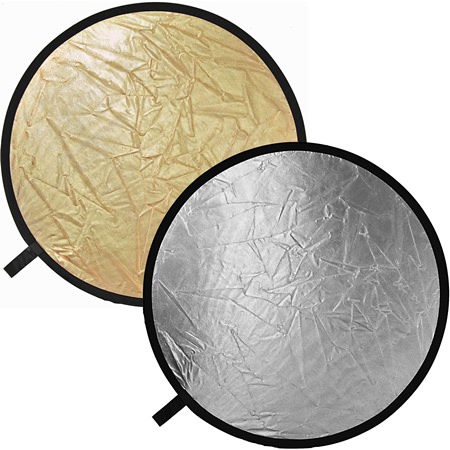
Information columns such as these are designed to give you something to absorb, and then after application, to reflect on the results. However, nothing quite so philosophical – I want to show you how some very simple reflectors and absorbers can be used to give your photos some sparkle and mystery.
Remembering that all of photography is really just “painting with light”, let us look at manipulating the available light using very simple reflectors and absorbers, and both cost next to nothing! Yet the difference these can make to your photos is remarkable.
I was given a silver and a gold reflector, very natty, fold away, store easily, carry easily reflectors. These particular ones even come in their own little zip-up bags to keep them warm and dry. They unfold to make a one and a half metre diameter circular reflector. Both are white on one side, but on the other, one is gold and the other is silver. However, they are very simple to make.
But first, why do you need a reflector? If they are so damn good, why aren’t we all rushing around with silver and gold reflectors tucked under our arms? The simple answer is that we get too complacent and we end up saying that the results we get are “good enough”, or we were just taking snapshots anyway. However, if you really want photos that leap off the page, think about reflectors!
The first thing a gold reflector can do for your photographs is to give skin tones that “golden glow” that just makes portraits look that much more pleasing.
So what else does a reflector do for your photographs? Well it allows you to photograph “contre jour” as they say in the classics. That is having the light behind your subject (generally the sun) and then you can throw some reflected light back into the subject’s face. If you do not do this, the usual result is something closer to a silhouette than a portrait – a bright halo around the subject which then becomes so dark in the face that you cannot distinguish the features. But with the reflector, you can push the light back in and pick up the details.
So that was the gold reflector – what about the silver one? Well, if you want “clean” and bright light on a subject anywhere, the silver reflector will do that for you. Best to use this type of reflector when photographing silver jewelry or even motor cars, for example. Mind you, if you are photographing gold jewelry you must use a gold reflector or otherwise the gold necklaces look silver in the photo.
Now, here’s how you make your own. Get some “foam core” – that lightweight plastic material that is often used to make signs (any sign makers will have some). Around one meter square is OK. Now go to the newsagents and buy some gold wrapping paper and some silver wrapping paper. Cover one side of the “foam core” with silver and the other side with the gold paper and you have lightweight, portable (you can fold them in half easily) silver and gold reflectors. And it has cost you less than a couple of hundred baht.
Now “absorbers”. To give your shots some shadow, or even an air of mystery, it is good to manipulate the amount of shadow in your portraits. You do this by placing something on the side of the subject away from the light source, to absorb (and not let light be reflected back into the subject) and allow a natural fall-off of light. The best absorber is black velvet. You bring the black velvet absorber as close as you can to the subject, without it coming into the viewfinder. It is that simple.
To make this absorber, use another one meter square sheet of foam core and cover one side with black velvet material. You pin or clip the material to it and that is it.
You will really be amazed by the way the use of a reflector and absorber can put a different atmosphere into your photographs – especially portraits. Try taking the same shot using different reflectors and note the difference for future use.
 |
 |
 |





